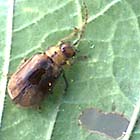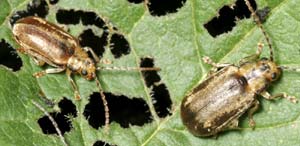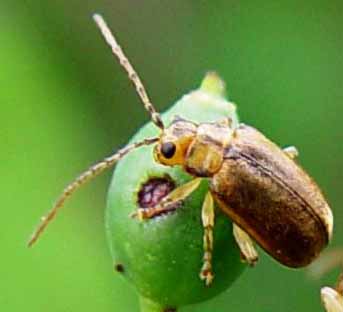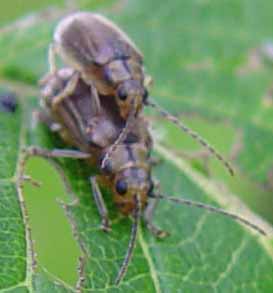Viburnum leaf
beetle home
Back to How to identify viburnum leaf beetles
Video:

Adult laying eggs
[3.4 MB .avi video by Jame Reilly. Need help?]

Adult feeding
[3.6 MB .avi video by D. Swaciak. Need help?]
Logo images by Kent Loeffler, Paul Weston & Craig Cramer
|
When to look: Late June to killing frost
What to look for: Brown and smaller than larvae, 4.5 to 6.5 mm (about one-quarter inch). Females are larger than males.
Where to look: On leaves but will drop off of plant or fly away when disturbed.
Adults can migrate, so look for them on plants that were not infested with larvae, as well as those that were.

Larger image. Photo by Kent Loeffler

Photo by Paul Weston
Adult on viburnum fruit.

Larger image Photo by Paul Weston
Pair of mating adults. Note that the female is larger than the male.

Adult next to adult feeding damage.
View video of adult feeding.
[3,724K .avi video by D. Swaciak. Need help?]
© Copyright, Department of Horticulture, Cornell University.
Project coordinator: Lori Brewer, ljb7@cornell.edu
Website design: Craig Cramer cdc25@cornell.edu
Mention of trade names and commercial products is for educational purposes; no discrimination is intended and no endorsement by Cornell Cooperative Extension or Cornell University is implied. Pesticide recommendations are for informational purposes only and manufacturers' recommendations change. Read the manufacturers' instructions carefully before use. Cornell Cooperative Extension and Cornell University assumes no responsibility for the use of any pesticide or chemicals. Some of the links provided are not maintained by Cornell Cooperative Extension and Cornell University. Cornell Cooperative Extension and Cornell University are not responsible for information on these websites. They are included for information purposes only and no endorsement by Cornell Cooperative Extension or Cornell University is implied. Cornell Cooperative Extension provides equal program and employment opportunities.
|